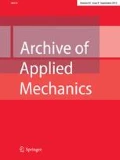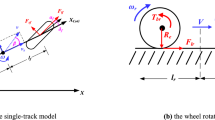Abstract
A nonlinear model of an aircraft braking system is presented and used to investigate the effects of damping on the stability in Chevillot et al. (Arch Appl Mech 78(12):949–963, 2008). It has been shown that the addition of damping into the equations of motion does not lead systematically to the stabilization of the system. In the case of a mode-coupling instability, there is indeed an optimal ratio between the modal damping coefficients of the two modes in coalescence, that maximize the stable area. But the stable area is not a sufficient criterion. In dynamics, the amplitude of the vibrations and the transient behavior characterized by the speed of increase of the oscillations are best indicators. In this paper, the same nonlinear model of the aircraft braking system is used to compute time-history responses by integration of the full set of the nonlinear dynamic equations. The aim of the study is to evaluate the effects of damping on the nonlinear dynamics of the brake. It is shown that damping may be very efficient to significantly reduce and slow down the increase of the friction-induced vibrations. But, in the same way as for the stability area, there exists a value of the damping ratio that optimizes the effects of damping.
Similar content being viewed by others
References
Chevillot F., Sinou J.-J., Mazet G.-B., Hardouin N., Jézéquel L.: The destabilization paradox applied to friction-induced vibrations in an aircraft braking system. Arch. Appl. Mech. 78(12), 949–963 (2008)
Ziegler H.: Die stabilitätskrieterien der elastomechanik. Ingenieur-Archiv 20, 49–56 (1952)
Bolotin V.V.: Non-conservative problems of the theory of elastic stability. Pergamon Press, Oxford (1963)
Herrmann G.: Stability of equilibrium of elastic systems subjected to nonconservative forces. Appl. Mech. Rev. 20(2), 103–108 (1967)
Walker J.A.: A note on stabilizing damping configurations for linear non-conservative systems. Int. J. Solids Struct. 9(12), 1543–1545 (1973)
O’Reilly O.M., Malhotra N.K., Namachchivaya N.S.: Some aspects of destabilization in reversible dynamical systems with application to follower forces. Nonlinear Dyn. 10(1), 63–87 (1996)
Kirillov O.N., Seyranian A.P.: Stabilization and destabilization of a circulatory system by small velocity-dependent forces. J. Sound Vib. 283, 787–800 (2004)
Kirillov O.N., Seyranian A.O.: The effect of small internal and external damping on the stability of distributed non-conservative systems. J. Appl. Math. Mech. 69(4), 529–552 (2005)
Gallina P., Trevisani A.: On the stabilizing and destabilizing effects of damping in wood cutting machines. Int. J. Mach. Tools Manuf. 43(9), 955–964 (2003)
Fritz G., Sinou J.-J., Duffal J.-M., Jézéquel L.: Effects of damping on brake squeal coalescence patterns—application on a finite element model. Mech. Res. Commun. 34(2), 181–190 (2007)
Sinou J.-J., Jézéquel L.: Mode coupling instability in friction induced vibrations and its dependency on system parameters including damping. Eur. J. Mech. A Solids 26(1), 106–122 (2007)
Hervé B., Sinou J.-J., Mahé H., Jézéquel L.: Analysis of squeal noise and mode coupling instabilities including damping and gyroscopic effects. Eur. J. Mech. A Solids 27(2), 141–160 (2007)
Kounadis A.N.: On the paradox of the destabilizing effect of damping in nonconservative systems. Int. J. Nonlinear Mech. 27, 597–609 (1992)
Bolotin V.V., Grishko A.A., Panov M.Y.: Effect of damping on the postcritical behaviour of autonomous non-conservative systems. Int. J. Nonlinear Mech. 37, 1163–1179 (2002)
Sinou J.-J., Fritz G., Jézéquel L.: The role of damping and definition of the robust damping factor (rd-factor) for a self-exciting mechanism with constant friction. J. Vib. Acoust. 129(3), 297–306 (2007)
Author information
Authors and Affiliations
Corresponding author
Rights and permissions
About this article
Cite this article
Chevillot, F., Sinou, JJ., Hardouin, N. et al. Effects of damping on the speed of increase and amplitude of limit cycle for an aircraft braking system subjected to mode-coupling instability. Arch Appl Mech 80, 1045–1054 (2010). https://doi.org/10.1007/s00419-009-0352-8
Received:
Accepted:
Published:
Issue Date:
DOI: https://doi.org/10.1007/s00419-009-0352-8




